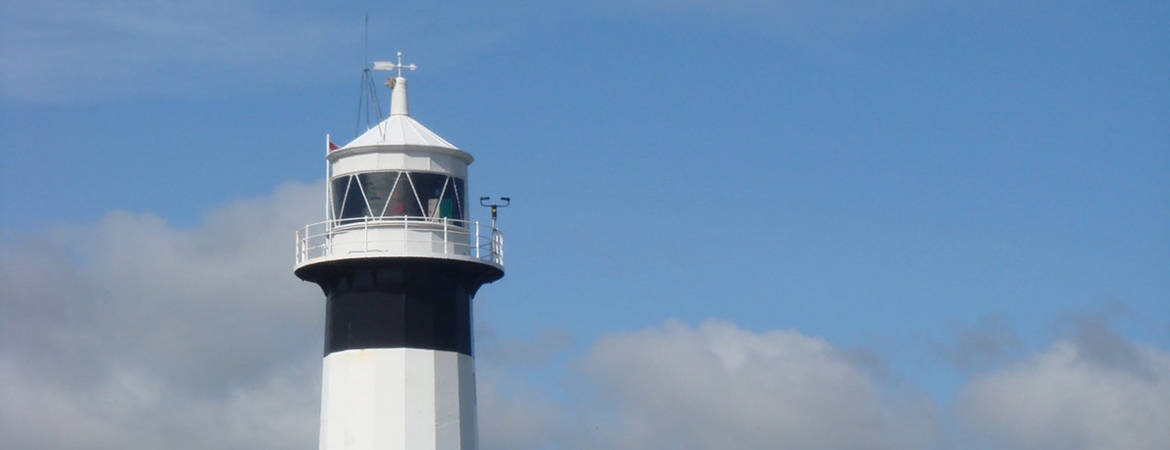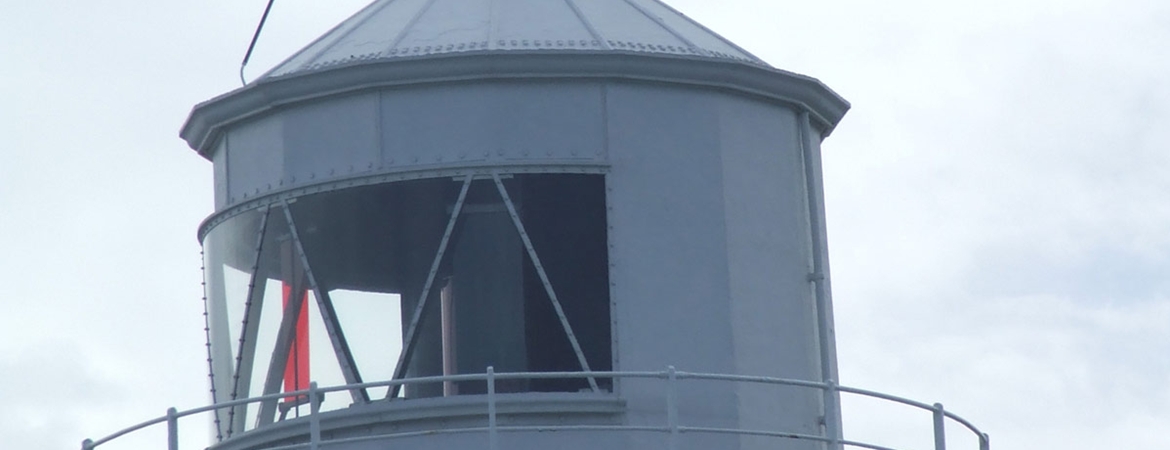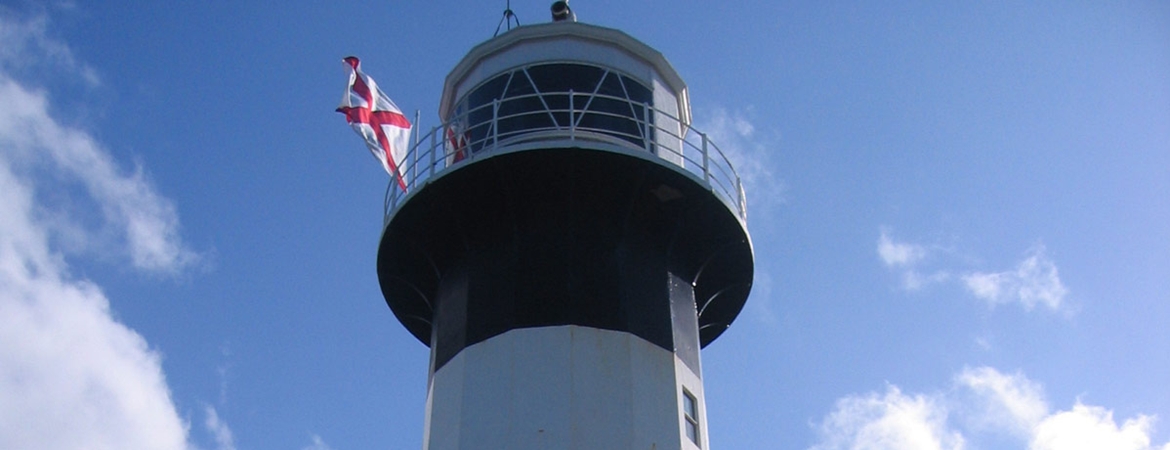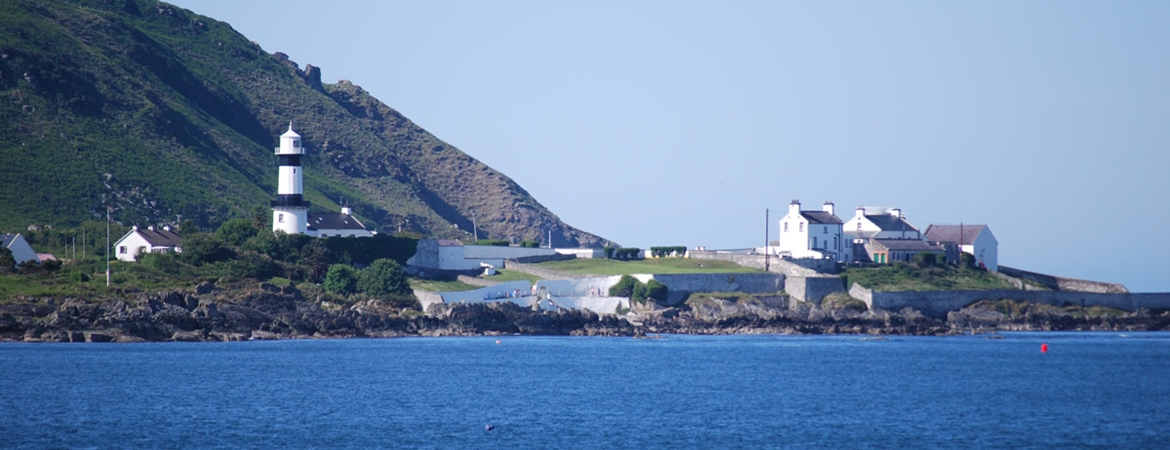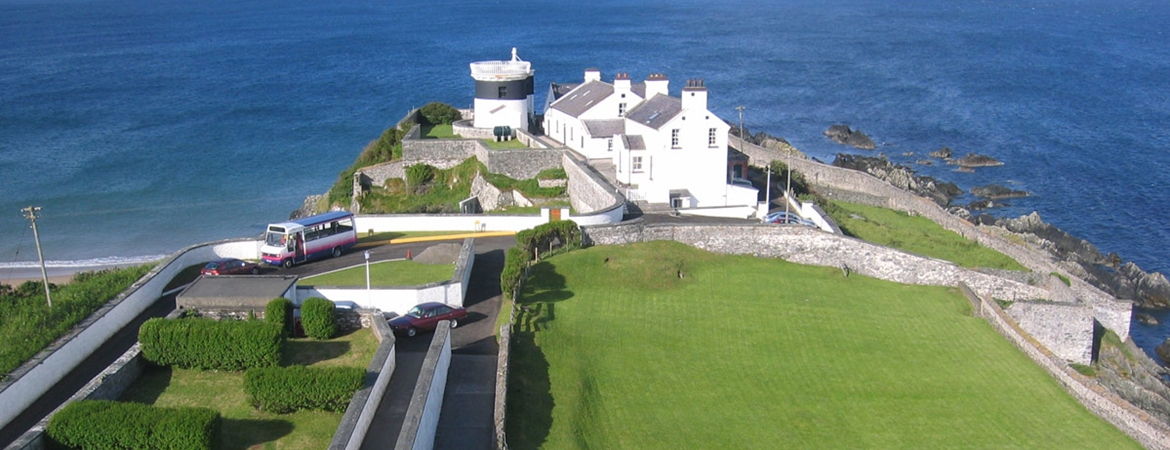Originally the two lighthouses built at Dunagree Point, 1 km south of Inishowen Head, were used as harbour lights to guide vessels into Lough Foyle and to lead them clear of the Tuns Bank.
Applications for a light at the entrance to Lough Foyle were made in January and March 1832 by the Derry Ballast Office and Chamber of Commerce respectively. The Board of the Corporation for Improving the Port of Dublin instructed Mr George Halpin, Inspector of Lighthouses, to proceed to Inishowen and check the locality.
After his return he reported that to obtain the desired object there should be two lights so as to clear the Tuns Bank, a spit of sand lying to the north east of Macgilligan's Point. The Board concurred and referred the report and correspondence to the Elder Brethren of Trinity House who gave their Statutory Sanction in June 1833 stipulating that the lights were to be considered as local and tolls should only be charged on vessels entering the Lough for trade or shelter. Sanction from the Lord Lieutenant was received the following month and by May 1834 Inspector Halpin reported that measures should be taken to obtain legal possession of the land required. An enquiry was held in Moville on 4th August 1834 to value the land and the result was that the fee should be purchased over a period of 20 years at £10.00 per annum.
Three proposals were received in May 1835 to build the two towers designed by Mr Halpin and that of Mr James Pettigrew of Dorset Street, Dublin, for £368, was selected. The two Keeper's dwellings and the rest of the station were built by the workmen of the Board again to Mr Halpin's design and under his supervision.
The twin towers bearing east and west were of cut stone, 153 yards (140m) apart. The overall height of each tower was 49 feet (15m) and they were painted white. The fixed white lights were 67 feet (20.4m) above high water and were established on 1st December 1837.
Four years later the Derry Ballast Office wrote to the Corporation enclosing requests from numerous mariners for a distinction to be made between the two lights. George Halpin pointed out that the west or inner light solely formed a leading light with the principal east light and did not show so much to seaward. He suggested placing a second light in the east tower in the room below the lantern. The Board agreed and ordered that the second light in the east tower should be established. In February 1847, after a further five years, the Ballast Office in Derry enquired about the distinguishing light to be shown at the east tower. George Halpin reported that the lamp and apparatus had been prepared and would be set up early in 1847. Two and a half years later the Derry Ballast Office again reminded the Corporation of the extra light, this time action was taken and the second light was exhibited on 1st January 1851 through the east facing window on the floor under the lantern 17 feet (5.1m) below the main light.
A letter from the Board of Trade was received in March 1854 enclosing another letter from the Admiralty which stated that the two lights at Inishowen were ill-adapted for the purpose of clearing the Tuns Bank due to their being at the same elevation. The Admiralty's remedy was to raise the west tower.
The immediate reaction did not go beyond two reports by Inspector Halpin and a request from the Board of Trade for an estimate for raising the west tower and a suggestion to lower the east.
Having heard about raising the inner tower the Derry Harbour Commissioners, in their letter in June 1860, mentioned to the Corporation the difficulty mariners had in distinguishing between the two towers and called for expediency in raising the tower. The matter was referred to the Inspector who, eleven months later, reported favourably to raising the tower which in turn received approbation from the Inspecting Committee in June 1861.
Yet again the subject was long fingered and early in 1864 the Derry Harbour Commissioners enquired if a decision had been made on the inner tower. The Inspecting Committee agreed that the introduction of a second light in the east tower had proved insufficient and that the two lights appeared as one even at a short distance but suggested that the problem may be overcome by altering the west light to red. The Board referred the subject to the Inspecting Committee on Tour who surprisingly did not report until September 1867. They said that they wanted to observe an improved light at Warren Point, 2.4km further up the Lough, under the jurisdiction of the Harbour Commissioners. But, according to the Committee, this had not improved the Inishowen situation, consequently the suggestion of a red light for the inner tower should be brought to the notice of the Elder Brethren who, the following month, sanctioned without question the change from white to red.
The Board of Trade conversely were not happy and they suggested abandoning the west and establishing a red sector in the east over the Tuns Bank. In May the following year, 1868, the Inspecting Committee on Tower recommended taking evidence on the spot with the Elder Brethren, pilots and others as soon as possible and report to the Board who by then had become the Commissioners of Irish Lights. Three months later Trinity House approved the Inspection Committee's report in which the inner or west tower was to be raised 25 feet (7.6m) and the Tuns Bank was to be marked by an Argand lamp with a red shade from an opening in the tower. Also modifications were to be made by the Derry Harbour Commissioners to Warren Point light to back up the changes to the made at Inishowen. Sanction was received from both Trinity House and the Board of Trade in September 1868.
Engineer-in-Chief J. S. Sloane submitted plans and an estimate in June 1869 which were sanctioned by the Board of Trade in August of that year and, in March 1870, was Mr E. Toomey's tender to supply the iron work for heightening the west tower. This apparently was completed early in 1871 because the Inspector Captain E. H. Hawes suggested in February that the lower or second light at the east tower should be extinguished and Trinity House sanctioned its discontinuance two months later.
The red sector light shown over the Tuns Bank from the west tower was through a glazed opening in the cast iron tower extension 25 feet (7.6m) below the main light, just above the granite blocking of the original tower.
Towards the end of 1871 an application from the Derry Harbour Commissioners requesting a fog gun was referred to the Inspecting Committee. The outcome was that the Board informed the Derry Commissioners that they would apply to the Board of Trade if the Derry Commissioners would undertake to pay the expense. Nothing further was done on the fog signal subject until October 1888 when a joint letter from three shipping companies urging the Board for the necessity of a fog signal at Inishowen Head. Another letter from the Derry Chamber of Commerce stating that in the interest of commerce and safety of human lives the subject should be dealt with promptly. They were informed that the Board were unable to place a fog signal on Inishowen Head as it was a local matter. The Derry Port and Harbour Commissioners expressed disappointment at the reply and drew attention to the increased trade of the Foyle; they too were informed that the Board had gone fully into the subject and regretted they were unable to give any other reply.
Twelve months later the Chamber of Commerce again drew the attention of the Board to the requirement for a fog signal at Inishowen. The Board referred them to previous correspondence. Not to be put off the Chamber wrote to the Board in February 1890 stating that a fog signal should be borne by the Mercantile Marine Fund and they would also bring the question before Parliament.
Over five years passed without incident then, in October 1895, the Harbour Commissioners again called the attention of the Board to the necessity for a fog signal. The Board referred the matter to the Inspecting Committee who in turn referred the Derry Chamber of Commerce to previous correspondence.
Between 1896 and 1900 considerable correspondence and discussion took place on the fog signal subject and the Board even went as far as obtaining both Trinity House and Board of Trade sanction to establish a siren fog signal, discontinue the west light and improve the east. Strong local objections were raised at the prospect of losing their leading lights although they appreciated the proposed establishment of a fog signal and improvement to the east light. The final result was that the project was reconsidered and the Inspecting Committee recommended to Trinity House to leave the lights as they are and to cancel their sanction as far as the lights were concerned.
During July 1900 a Notice to Mariners was issued to state that a siren fog signal with a character of two 2 second blasts; one low, one high, every minute (2 x 3 x 2 x 53) would be established on 1st October 1900. A third, two storey dwelling was built to accommodate the additional two assistant keepers required for fog signal duty, although only one was appointed until 1912.
Following Inspector Dean's suggestion in November 1907 that black bands should be painted around the towers to make them more conspicuous the Inspecting Committee recommended one black band on the east tower and two on the west. Trinity House gave their sanction in July 1908 and the bands were added to the towers in the summer of 1909.
In May 1929 Inspector Davis suggested discontinuing the auxiliary light but the Inspecting Committee recommended in September that an acetylene plant be installed and both the main and auxiliary lights at the west be made unwatched. This was carried out and the Inspector reported that the conversion to unwatched acetylene took place on 5th March 1932. The main light character changed from fixed white to two white flashes every 6 seconds and the auxiliary light from fixed red to two red flashes every 6 seconds, the east light remained manned and fixed.
The keeper strength was reduced by one Assistant Keeper to a Principal Keeper and two Assistant Keepers.
On 19th January 1941 a fire in the fog signal engine room damaged roof timbers and destroyed a five gallon oil supply tank. The cost, by November 1941, was over £1,000 to make good and repair damage and remove the large oil tanks out of the engine room. The Engineer, Mr Tonkin, proposed alterations for improving the fog signal and the decision was that the siren be replaced by a "G" type diaphone and the two 41 year old Campbell engines and compressors be replaced by Ruston engines driving Reavell compressors. The diaphone with a character of one 2 second blast every 30 seconds came into operation on 18th September 1942.
The Tuns buoy was moved so the red sector was extended by 10° in June 1950.
With the spread of rural electrification the Inspecting Committee recommended in 1953 that the lights be converted to electric. Progress was slow and overhead cables were not in the area until 1958. The dwellings were the first to be converted to electric. Meanwhile a rethink had been made on the lights in so much as the Inspecting Committee in 1957 decided to abandon the front light and auxiliary light and replace the acetylene light in the rear tower by an electric light in a catadioptric lens with a red sector over the Tuns Bank.
The leading lights were discontinued on 15th May 1961 and a temporary light was established on the balcony of the east tower whilst alterations were made to the west tower light.
The lantern glazing had to be increased from 90° to 180° and the old French 500mm optic from Blackrock (Sligo) was refurbished by Stone Chance. By 9th July the temporary light on the east and the auxiliary light in the west tower were discontinued and the new electric light from the rear tower came into operation with a red sector over the Tuns. The character was Gp Fl (2) WR every 10 seconds. The lantern on the east tower was removed subsequently.
A green sector was introduced to the north of the white so as not to be confused with the red to the south, on 14th December 1962 having been recommended by the Inspecting Committee in 1961. Since 1978 the light has been exhibited in poor visibility when the fog signal is sounding.
The station was automated on 31st August 1979 when the Keepers were withdrawn and replaced by an Attendant. The diaphone was replaced by an electric fog horn controlled by a fog detector. With a character of two blasts every 30 seconds. The light is currently a 250mm catadioptric cylindrical refractor with 290mm spherical mirror and electric L11 lamps in a LC15 lampchanger.
If the electricity supply fails a 12kW standby generator automatically takes over until the supply is re-established. Consideration was given early in 1979 to make the station more compact by moving the cast iron extension on the west tower to the east tower but the Inspecting Committee on Tour in 1979 decided against this recommendation.
In May 2007 the fog signal was permanently disestablished. The light continues to be exhibited in conditions of poor visibility during daylight hours.
The Attendant lives in the house nearest to the lighthouse and the other two dwellings have been converted into staff holiday houses.

